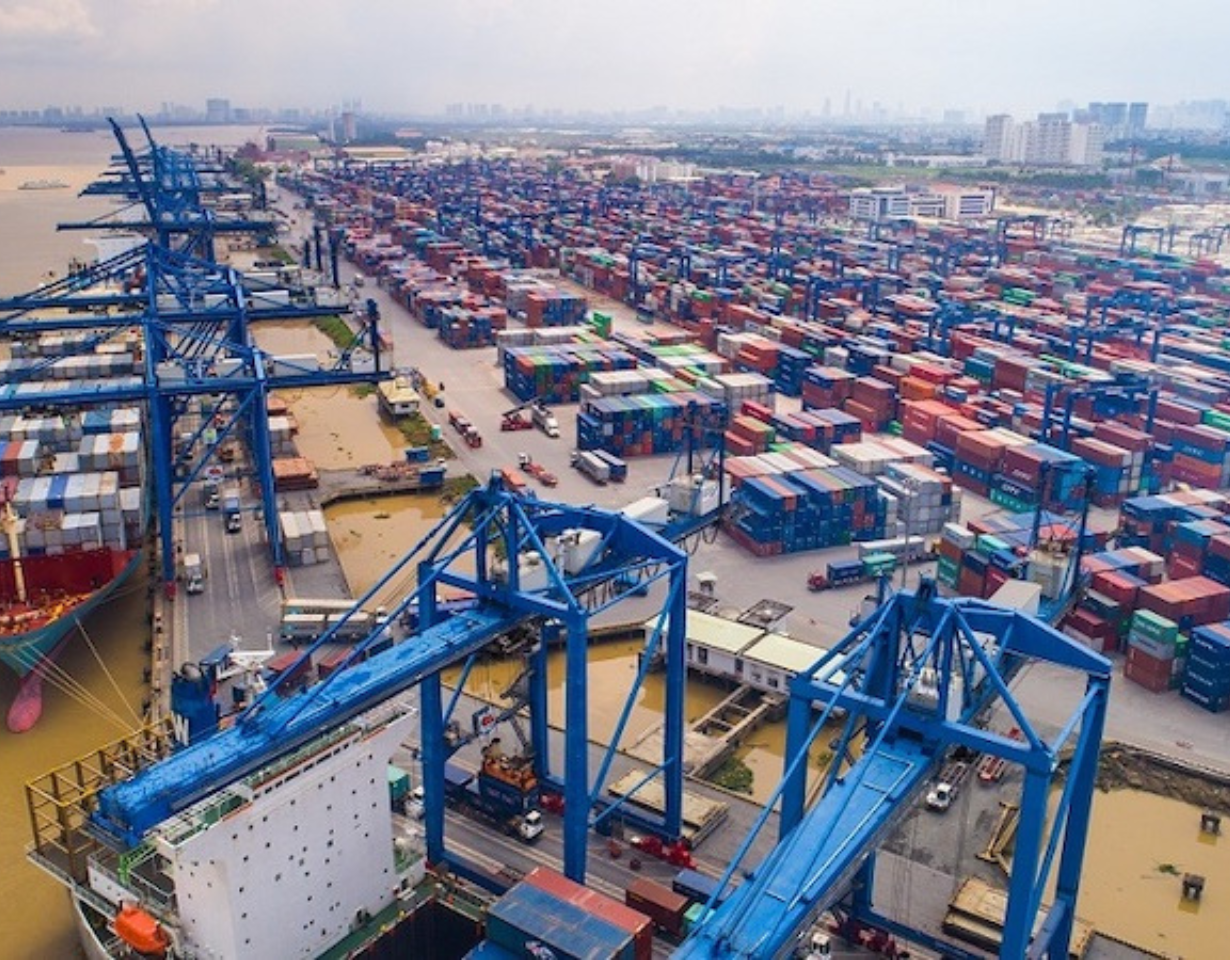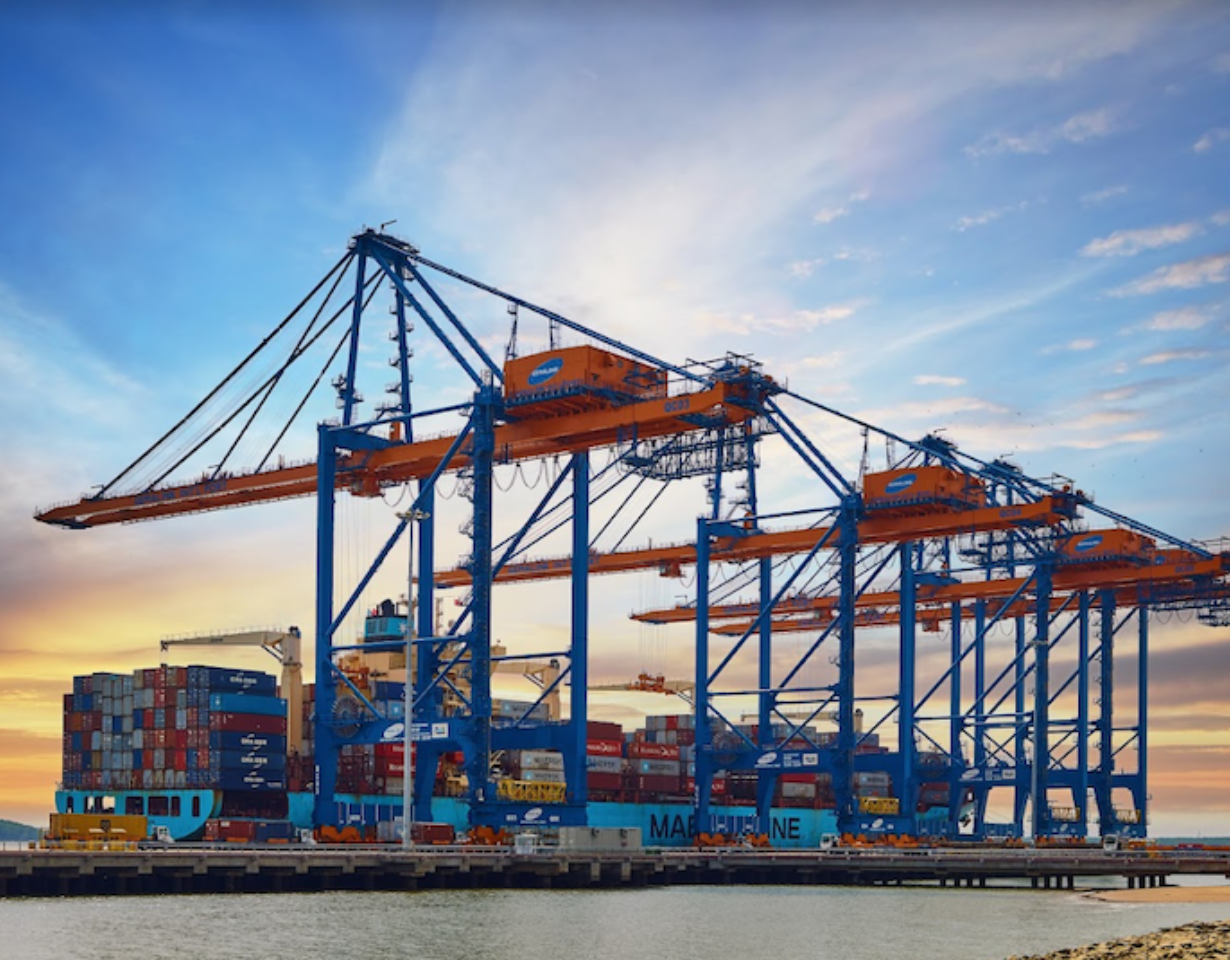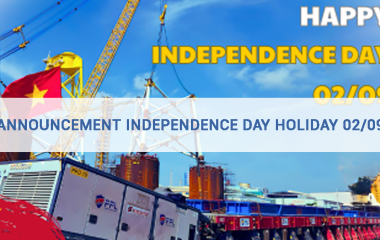Logistics enterprises grasp the trend of "greening"
Vietnam's logistics service industry is approaching and strongly developing towards green logistics associated with digital transformation.
The trend of green and intelligent logistics is developing strongly in the world logistics service industry. Vietnam's logistics service industry is also approaching and growing in a modern direction: Green logistics is associated with digital transformation.
 Tan Cang - Cat Lai port in Ho Chi Minh City is the first port in Vietnam to win the title of Green Port of the APEC Port Service Network Council.
Tan Cang - Cat Lai port in Ho Chi Minh City is the first port in Vietnam to win the title of Green Port of the APEC Port Service Network Council.
Essential requirements
Not only that, but green logistics is also a trend and a requirement in realizing the goal of "surpassing the storm" of the logistics industry in 2023 and the coming years, in order to fulfill the requirements of green logistics activities of countries and regions. partner enterprises are regulated in the new generation FTAs.
Green logistics also actively contribute to reducing carbon emissions into the environment towards implementing the strong commitment of Prime Minister Pham Minh Chinh at COP26 that Vietnam will have "zero net emissions by 2050".
After first mentioned in the 1980s, the term “green logistics” has been used by many organizations and researchers who have come up with different concepts of green logistics from many different approaches. Green Logistics can be understood as logistics activities towards sustainable, friendly, and environmentally friendly goals, minimizing negative impacts on the environment.
Green logistics are efforts to measure and minimize the ecological impact of logistics activities. It includes all forward and reverses operations of products, information, and services between the place of origin and the place of consumption. The aim is to create sustainable value by balancing economic and environmental performance. Bring economic benefits to businesses and society as a whole.
The three main components of Green Logistics include Economy, Society, and Environment. Green logistics development emphasizes on efforts and measures to minimize the negative impacts of logistics activities, thereby achieving a sustainable balance between economic, social, and environmental goals. According to the green logistics development framework, green logistics governs all three economic, social, and environmental goals simultaneously. These three goals are not mutually exclusive, but on the contrary, reinforce each other. All efforts of green logistics are focused on contributing to and ensuring sustainable development with high economic efficiency.
The main content of green logistics development needs to be focused on, firstly, greening transport activities Transportation is a logistics activity that has a great impact on the environment.
There are two main factors of transport that affect the environment, including the transport network system and the operation of the means of transport. Transport vehicles use a lot of fuel and emit harmful emissions into the environment. In particular, road vehicles have the most impact on the environment, reflected in emissions, noise, and traffic congestion. Moreover, roads, airports, and ports are being built more and more which are major sources of pollution. The optimization of two-way freight transport by means of transport, especially cars, aims to reduce environmental pollution and increase transport efficiency. Choosing the right mode of transport in logistics activities also contributes to the impact on the environment.
Second, greening warehouse operations. The design and construction of the warehouse directly affect the energy usage of the warehouse. Warehouse design and construction not only require ensuring safe storage of goods such as maintaining good humidity, anti-corrosion, waterproofing, anti-deformation, anti-evaporation, and no leakage ... but also must meet environmental standards. Warehouses with eco-friendly features such as using solar energy, natural light, suitable space, thick walls, and floors or allowing on-site recycling will save energy, and reduce noise and emissions to the environment.
In addition, choosing to use environmentally friendly warehouse equipment and optimizing warehouse operations also reduces negative impacts on the environment. Good warehouse space planning not only helps to make optimal use of warehouse space but also cuts down on the movement in the warehouse. This forces businesses to choose the green design of warehouses to not only achieve economic efficiency but also increase the greenness in their logistics activities. In addition, the working environment and trees around the warehouse area also contribute to green logistics. Cleaning equipment containers should be paid attention to reduce waste and pollute the environment.
Third, greening packaging operations. Packaging is an important process for all products before they go to market. There are usually three types of packaging primary packaging, secondary packaging, and shipping packaging. The main packaging contains the product. The size, shape, and material of the packaging have an impact on warehouse and shipping costs.
Better product packaging with reused materials and optimally patterned pallets results in significant cost savings through reduced material usage, and increased warehouse space utilization and capacity means of transport, reducing the amount of packaging that needs to be handled. Inappropriate packaging can lead to product damage during transportation and waste packaging, increasing the amount of waste released into the environment. As a result, innovative packaging technology will help minimize product loss during transit, while reducing the impact on the environment. It is also important to recover excess material after completing the pack pile.
Fourth, greening the information system. A perfect information system can increase the level of greening logistics activities by providing real-time information and accurately and optimally controlling logistics activities such as packaging, storage, and transportation. storing, transporting, processing, distributing, loading and unloading, handling inventory... in order to comply with economic as well as environmental requirements, facilitating the implementation of logistics services associated with a responsible environment.
In addition, the digitization of data not only improves operational efficiency, increases labor productivity, and is convenient for information retrieval and data management, but also reduces printing and paperwork. harm to the environment. In particular, the network of information links between businesses and specialized agencies will reduce administrative procedures, save time as well as limit movement, contributing to minimizing adverse impacts on the environment.
Fifth, the development of green logistics is indispensable for the development of reverse logistics. Consists of two main activities: product recovery and reuse and waste treatment. Reverse logistics is the process by which businesses recover products returned by customers, products in need of warranty, maintenance, or end-of-use products and packaging from the end consumer; make use of recycled materials, waste products, and by-products in the production process; Collecting scraps from packing and transporting materials.
Therefore, reverse logistics activities will contribute to environmental protection and bring many benefits to the sustainable development of enterprises. Waste management is important content for environmental protection and resource conservation. For example, when a warehouse generates a large amount of packaging waste or when products are expired or damaged, they become waste. At that time, how to treat waste so as not to affect the environment is extremely important.
Support for businesses
From this fact, in order to implement green logistics development associated with enterprise's digital transformation, first of all, on the Government side, it is necessary to develop a Strategy and Planning for Logistics Development to 2030, with a vision to 2050. In which, focus on developing green logistics and environmentally friendly solutions.
 Gemalink deep-water port is a typical project for the green port industrial urban area model.
Gemalink deep-water port is a typical project for the green port industrial urban area model.
Along with that, speeding up the digital transformation process, and promoting the application of information technology. Planning and building infrastructure for green logistics activities, continuing to improve infrastructure towards modernity, improving infrastructure quality, and facilitating multimodal transport. It is necessary to invest in, upgrade and plan a suitable warehouse system.
In particular, completing a synchronous legal framework for green logistics activities, avoiding overlap between ministries and agencies. It is necessary to have a set of criteria to measure the level of green logistics development for the logistics industry in an overall, more inclusive perspective, including sets of criteria for seaports, warehouses, packaging, ... green. Encourage and promote green logistics in small and medium enterprises.
For businesses, it is necessary, first, to change awareness in implementing green logistics and have a specific action plan on green logistics. From there, set out requirements and green logistics content for specific activities and services. First of all, green logistics in corporate agencies.
Currently, there are many large logistics service providers who are interested in implementing green logistics development, especially enterprises in the field of shipping and seaports with specific evaluation criteria. And so far, it has been specified by the Government in Decision No. 1909/QD-CHHVN on the publication of basic standards. For example, among these are enterprises such as Saigon Newport Corporation, Gemadept Joint Stock Company, Vietnam Maritime Corporation, etc.
Accordingly, businesses have built green ports with the goal of harmonizing economic development and environmental protection with the goals of saving fuel, using clean fuel, and building and applying environmental protection measures. environmental protection and friendliness, ensuring security and sustainable development according to international standards to ensure the environmental quality of the Port.
At the same time, using clean fuel at the port, treating waste in the port, building the ecological environment in the port area; developing measures to adapt to climate change and sea level rise; ensure harmony between road transport, waterway, and sea transport; applying 4.0 technology to the management of port operations; replacing petrol and oil fuels with electricity – such as using electrical equipment instead of diesel, using solar energy to light offices, providing shore power for ships; implement IMO regulations on pollution prevention to global limits; practice energy saving; conduct training of human resources to adapt and implement the above green and clean goals, especially the safety, security and environmental protection objectives of the Port; have procedures for handling dangerous goods; conduct propaganda to raise awareness about logistics among officials and employees working at the port...
Secondly, for enterprises providing transport and forwarding services, the core logistics activities need to develop plans to save fuel for transportation vehicles and save water used in logistics activities.
The issue of using clean raw materials, especially in production and supply, prioritizing the use of energy-saving means of transport, considering the exploitation and expansion of the application of liquefied petroleum gas, natural gas, electricity, and fuel mixtures, and biofuels to replace gasoline and oil in order to protect the environment for the ultimate purpose of green logistics.
Limiting direct discharge into the environment, especially with untreated waste, is on the right track in the direction of sustainable development of green logistics. Strictly follow the process of transporting substances that can cause negative effects if in direct contact with the environment (chemicals, grease, dangerous goods).
Therefore, it is necessary to have more work to ensure safety during the transportation of goods, to avoid causing adverse impacts on people and the environment.
Consider using reusable, recyclable materials to make shelves, pallets, and packaging. The use of recycled materials is an important issue in optimizing and cutting logistics costs.
Third, businesses need to develop high-quality human resources. Factors related to high-quality human resources play a very important role in the development of green logistics. The determination of senior management as well as the requirement for a high-quality human resource that is not only good at professional skills, good at information technology but also has an understanding of green development, saving and optimizing all resources force will be the key to successfully implementing all strategies and plans for green logistics development at enterprises.
Green logistics, smart logistics associated with "innovation, creativity, digital transformation" as the action program that the Resolution VIII Congress of the Vietnam Logistics Business Association (VLA) has set out is one objective and urgent requirement for the current VLA member enterprises. To promote its role, the Association needs to have a specific plan, guide, and support members to implement the green logistics development plan, and at the same time have a form of encouragement, reward, and encouragement for members who perform well in logistics green, bringing economic benefits, developing national logistics services, thereby reducing logistics costs, enhancing service capacity and promoting the competitiveness of our country's economy.
Related Posts
New Posts
- HOLIDAY ANNOUNCEMENT: REUNIFICATION DAY & INTERNATIONAL LABOR DAY (April 30 - May 1, 2025)
- ANNOUNCEMENT OF HUNG KINGS’ COMMEMORATION DAY 2025
- PTSC Thanh Hoa and PPL Sign Strategic Partnership
- INDEPENDENCE DAY HOLIDAY ANNOUCEMENT
- PPL Teambuilding 2024: Uniting Our Strength, Igniting Success!
- Charity Program Warms Hearts Of PPL in Phuoc Hai Town


_cr_380x240.png)




Comments